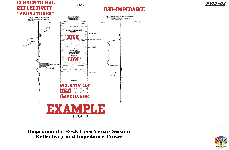|
 DvC1-03 (Core, Reflectivity, Impedance Traces) DvC1-03 (Core, Reflectivity, Impedance Traces)
For a simplified earth model, represented by the schematic core drawing, Figure DvC1-03 exhibits two seismic traces that might be produced by the Convolutional Model. It assumes that every sample on a "Reflectivity Amplitude" trace is a digital "convolution" (sample-by-sample, cross-multiply and add, to produce each output sample) of two time series. The first one is a relatively short, digital seismic "wavelet" (such as the trough-peak-trough labeled 304), and the second series is a longer "earth function" or "reflection-coefficient" time series of digital samples. The amplitude of each reflection-coefficient sample, in the series, is defined to be the fraction of the incident acoustic wave amplitude that will be reflected at this particular, two-way-time layer boundary (the Convolutional Model is layer-based), and can be shown to be equal to the quotient,
[(Impedance below) - (Impedance above)] / [(Impedance below) + (Impedance above)].
Or (non-mathematically), the change in the acoustic impedance, DIVIDED BY the sum of the acoustic impedances, above and below the boundary.
The two traces shown are schematic examples of the:
-- Conventional reflection-coefficient amplitude trace (left side, labeled 300), and
-- an "Inverted", relative acoustic impedance trace (right side, labeled 312).
Both traces contain samples whose amplitudes are purely relative, with values ranging from -1 to +1. In this Figure, the traces are placed next to a drawing of the theoretical rock column (represented by a schematic drawing of a conventional core) that, if extended indefinitely in all directions, would generate the two opposite polarity echoes shown (302 and 304) from the top and bottom of a low-density, low-velocity gas sand sandwiched between two identical-property shale layers. Here, the velocity and density of the identical shale layers above and below are assumed to be higher than the velocity and density of the sandstone reservoir layer.
For a Positive Physical Polarity seismic amplitude (band-limited reflection coefficient series) display, a "negative" wavelet pulse (or a "trough) is seen at the top of the reservoir, and a "positive" pulse ("peak") is seen at the base. Using basic Physics of Seismology principles (conservation of energy and momentum), and some reasonable layered-earth approximations, it can be shown that running-sum integration of the reflection coefficient (relative CHANGES in acoustic impedance) trace samples, produces the (relative natural logarithm of the) acoustic impedance trace samples. This is the only "inversion", from a band-limited reflectivity amplitude time series to a pseudo-acoustic impedance series (the so-called "D3D-impedance" trace) employed by the D3DSP.
Because there are sometimes high-amplitude (noisy) samples near the top (zero time) of any individual trace, one or more high-amplitude samples can skew all the subsequent impedance trace samples (adding a "DC component"), and it is usually prudent to follow the trace sample summation, by a low-cut filter designed to eliminate this processing artifact (usually not representative of any real, layered or objective geology).
|

